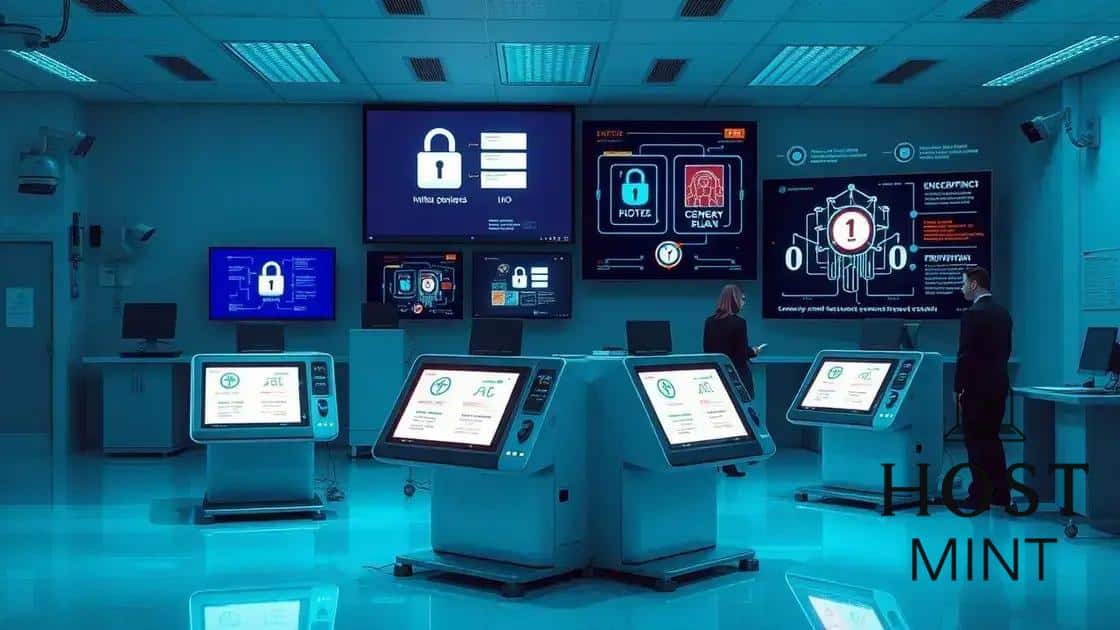Election security innovations being tested in 2025

Election security innovations being tested in 2025 include technologies like artificial intelligence and blockchain, aimed at enhancing integrity, public trust, and overall election efficiency while addressing challenges in implementation and cybersecurity.
Election security innovations being tested in 2025 highlight the need for safeguarding our democratic processes. Have you ever wondered how technology might shape the integrity of future elections? Let’s dive into the exciting advancements ahead.
New technologies ensuring election integrity
New technologies play a vital role in ensuring election integrity. As we look at upcoming elections, these innovations promise not only to enhance security but also to make the voting process more accessible for everyone.
One key advancement is the use of blockchain technology, which can create an immutable and transparent record of votes. This technology ensures that each ballot is securely recorded, providing a reliable audit trail. In addition to blockchain, biometric verification is gaining traction. By using fingerprints or facial recognition, election officials can confirm voters’ identities, reducing the chances of fraud.
Benefits of new election technologies
These new systems offer several significant benefits. They help build trust among voters and improve the overall efficiency of the voting process. Each technology brings unique advantages:
- Improved security: Reduces risks of tampering and fraud.
- Enhanced accessibility: Technology makes it easier for all eligible voters to participate.
- Faster results: Digital systems can report outcomes more quickly than traditional methods.
As these innovations continue to be tested and refined, it’s crucial for states to invest in training and resources. Election officials must understand how to operate these new systems effectively. Continuous education will ensure that technology is implemented efficiently and that all voters feel confident in the process.
Public engagement is another essential aspect of adopting these technologies. Informing voters about how these systems work can ease concerns and skepticism. It’s vital for community members to see the benefits firsthand, and outreach efforts can help make that happen. By fostering an informed electorate, states can enhance trust and participation in the electoral process.
Impact of public engagement on security measures

The impact of public engagement on security measures is significant, especially when it comes to elections. Engaging the public helps build trust in the electoral process and enhances the overall effectiveness of security initiatives.
Community involvement is essential for raising awareness about election security. When people understand the measures in place, they are more likely to feel confident about their votes being counted. In turn, this can lead to increased voter turnout and participation. Educating citizens about the technologies used, such as voter verification systems and secure ballot tracking, helps demystify these processes.
Ways to engage the public
Different strategies can be adopted to ensure that citizens are actively engaged in election security conversations:
- Workshops and forums: Hosting events where officials explain security measures can help clarify doubts.
- Social media campaigns: Utilizing platforms to disseminate information broadly raises awareness of election integrity.
- Surveys and feedback: Gathering input from the community can aid in refining security practices based on public concerns.
Moreover, when the public feels they have a voice, they are more likely to support innovations in election technology. This collaboration can lead to important feedback regarding the usability and accessibility of voting tools. Engaging communities in testing new systems can help identify potential issues before they affect the actual voting process.
Additionally, transparency in implementing security measures invites constructive dialogue between election officials and voters. This communication can relieve anxiety around potential vulnerabilities, fostering a sense of shared responsibility for securing elections. When people feel informed and involved, they become willing partners in safeguarding the democratic process.
Evaluation of pilot programs across states
The evaluation of pilot programs across states is crucial for understanding how new election technologies function in real-world scenarios. By examining these pilot programs, stakeholders can determine their effectiveness, identify challenges, and make necessary adjustments before wider implementation.
Many states have initiated these pilot programs to test new voting technologies. For example, some states have focused on electronic voting machines, while others have experimented with online voting systems. Each program provides valuable data on usability and security. Regular assessments help ensure these technologies meet both security standards and voter needs.
Key metrics for evaluation
When evaluating pilot programs, several key metrics can provide insights into their performance:
- User satisfaction: Collecting feedback from voters helps gauge their comfort with new systems.
- Error rates: Tracking errors during voting can highlight potential areas for improvement.
- Accessibility: Assessing how well the technology serves all demographics is essential for inclusivity.
Using these metrics, election officials can form a clearer picture of the technology’s impact. For instance, improvements in user satisfaction can indicate that voters are adapting well to new systems. Conversely, high error rates may signal the need for additional training for poll workers or further technology refinement.
Furthermore, collaboration among states enhances the evaluation process. Sharing experiences and outcomes allows jurisdictions to learn from each other. States with successful programs can offer guidance on best practices, while others can streamline their approaches based on collective insights. This collaborative spirit not only strengthens the democratic process but also paves the way for innovative solutions.
Challenges faced in implementing innovations

The challenges faced in implementing innovations in election security are multi-faceted and require careful consideration. As new technologies are introduced, stakeholders must navigate various obstacles to ensure successful integration.
One major challenge is the cost associated with adopting new systems. Many jurisdictions have limited budgets, making it difficult to finance advanced technologies. This can lead to delays in implementation and may prevent smaller regions from keeping up with advancements.
Integrating new technologies
Another significant hurdle is training election officials and poll workers. It is vital for these individuals to understand how to operate new systems effectively. If they are uncertain about the technology, it can lead to errors and increased voter frustration. Ensuring comprehensive training programs can mitigate this issue.
Additionally, there are concerns about public trust. Voters may be skeptical of new technologies, fearing possible misuse or security breaches. Building confidence among the electorate is crucial. Conducting public outreach initiatives can educate voters on how innovations strengthen election security.
Technical challenges
Technical issues are another aspect to consider. New systems must be compatible with existing infrastructure. Failure to integrate properly can result in disruptions during elections. Ensuring robust testing phases for all new technologies can help identify potential problems before they affect actual voting.
Moreover, maintaining security while implementing innovations is of utmost importance. As technologies evolve, so do the tactics of those who may wish to exploit them. This ongoing battle requires constant updates to security protocols and a focus on cybersecurity measures.
Lastly, compliance with regulatory frameworks presents challenges as well. Navigating local, state, and federal regulations can complicate the implementation process. Each new technology must adhere to these standards, which can vary greatly across jurisdictions.
Future of election security post-2025
The future of election security post-2025 is focused on advancing technology and strengthening public trust. With the rapid evolution of digital tools, election officials are optimistic about what lies ahead.
One significant trend is the adoption of artificial intelligence to enhance security measures. AI can analyze data patterns and detect anomalies, allowing for quicker responses to potential threats. This technology helps ensure that elections remain fair and transparent.
Emerging technologies
Alongside AI, the use of blockchain technology may become more prominent in elections. This decentralized approach can provide a secure and tamper-proof method for recording votes. Voters may have more confidence in the process if they know their ballots are securely stored and verified.
Moreover, improvements in cybersecurity protocols are essential as threats continue to evolve. Election officials need to work with cybersecurity experts to safeguard their systems against potential attacks. Regular updates and thorough testing of security measures will be a priority moving forward.
Public education and engagement
Another critical aspect of the future of election security is public education. Voters must understand how new technologies work and the benefits they bring. By fostering an informed electorate, election officials can build trust and confidence in the electoral process.
Outreach programs, workshops, and social media campaigns will play a crucial role in educating the public. When citizens are well-informed, they are more likely to participate and support innovations in election security.
Finally, collaboration between states and federal agencies will be vital for creating unified standards in election security. Sharing best practices and technological advancements can help all jurisdictions improve their systems. This collective approach can lead to a more secure and trustworthy electoral process for everyone.
FAQ – Frequently Asked Questions about Election Security Innovations
What technologies are being tested to enhance election security?
Technologies like artificial intelligence, blockchain, and biometric verification are currently being tested to improve election security and integrity.
How can public engagement impact election security?
Public engagement builds trust, educates voters about new systems, and increases overall participation, making elections more secure.
What challenges do states face in implementing new election technologies?
Challenges include budget constraints, the need for training election officials, and ensuring public trust in new systems.
What is the importance of evaluating pilot programs?
Evaluating pilot programs helps identify the effectiveness of new technologies, addresses issues before widespread use, and ensures they meet security standards.






